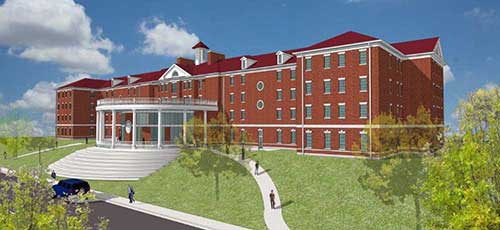
This rendering of the new Franklin Residential College, facing Chestnut Street, will be updated in the next few weeks after the next Board of Regents meeting.
With about a month to go before construction on the New Franklin Residential College starts, students passing across the bridge to the residential side of campus can already see preparation for the project underway.
The city of Murray began preliminary site work this week, relocating a gas main in the empty lot behind the Martin Luther King Jr. memorial, the future home of New Franklin.
The construction of New Franklin is the next step in the ongoing project to renovate all Residential Colleges on campus.
David Wilson, director of Housing and Residence Life, said since the construction of Lee Clark and James H. Richmond residential colleges in 2007 and 2009 respectively, there have been plans for the replacement of all the old low-rise residential colleges including Franklin, Old Richmond and Springer Residential Colleges.
Wilson said the low rises were built in the 60s and there have been improvements in construction practices that allow for a better product.
“From what I understand, the old low rises were built with a life expectancy and were to be replaced at some point,” he said.
Wilson said the diligent work of the Facilities Management staff has enabled the buildings to surpass that life expectancy but the University still needs to move forward with the plan to replace them.

This plan includes the construction of a New Springer Residential College as well as the renovation of the remaining high-rise residential colleges over the course of the next 10 years.
Ultimately, this plan will culminate in the demolition of all of the low-rise residential colleges on campus whose space will be used for undetermined purposes.
Jason Youngblood, assistant director of Facilities Management, said the construction of New Franklin is out to bid with a deadline of March 5 for competing contractors to submit their budget proposals.
The beginning of the site work for New Franklin is scheduled to begin in mid to late March and be completed in 16 months, in time for the fall 2016 semester.
Youngblood said the fast turnaround from accepting the bid proposal to breaking ground on the project is not the biggest problem contractors will face.
“Not being able to tear down another building to build this one – that’s probably the biggest challenge,” he said. “It would be nice to have more space, but we can’t make more room for buildings than we already have.”
Youngblood said the decision was made to keep Franklin standing during the new facility’s construction so as not to displace students. This was a problem during the renovations of Hester and Elizabeth Residential Colleges.
The construction of New Franklin, as estimated in the University’s 2015 capital plan, will cost approximately $28 million. The building will be LEED Silver certified, meeting energy-efficient and green guidelines as stipulated by the U.S. Green Building Council.
New Franklin will be a little larger than Clark and similar in design, holding approximately 380 beds in the form of single, double and suite-style rooms.
Don Robertson, vice president of Student Affairs, said the main feature of the new building will be the addition of numerous meeting spots and lounge areas for both students, faculty and staff to utilize, including a 100-person capacity conference room.
“We wanted to create more spaces for interaction and we wanted to have more ways for faculty when they come to the facilities to do programs to do activities,” Robertson said. “We’ll also have an area that is conducive to teaching classes in the new building.”
Also set to break ground this semester is the New Engineering and Physics Building that is expected to be completed by the fall of 2016.
Robertson said he doesn’t think the simultaneous construction will be a hindrance to campus life, but is instead a sign of Murray State’s vitality.
“I think what it does is show that we are growing- that we’re improving the facilities,” he said. “To me, if you see a lot of construction of the projects on campus going on that’s the sign that things are progressing. It shows we’re going to be even better able to serve our students.”
Story by Ben Manhanke, Chief Videographer



























































































